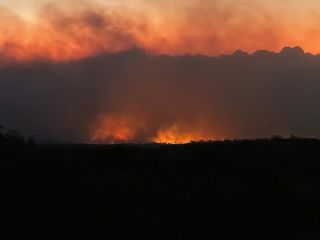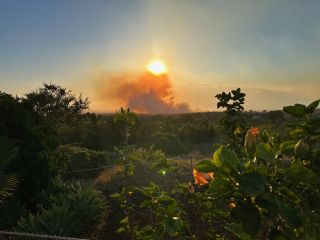Environment
What the People of Maui Can Teach About Facing Disasters
Personal Perspective: Climate change is intensifying. These lessons are vital.
Posted August 21, 2023 Reviewed by Gary Drevitch
Key points
- The wildfires on Maui destroyed the historic town of Lahaina; between 114 and 1,000 lives were lost.
- Lahaina was once the seat of the Native Hawaiian government and monarchy; the cultural loss is devastating.
- As the island population grieves, the Spirit of Aloha lives on.

Note: Coauthor Rose Sword is part Hawaiian and lives in Kula, one of the areas affected by the recent fires on Maui.
On Tuesday, August 8, 60-to-80-miles-per-hour winds generated by Hurricane Dora, a category 4 storm 700 miles south of the Hawaiian island chain, stretched a long tendril north and fiercely whipped it across the island of Maui. The winds knocked down or snapped dozens of utility poles, leaving live electric wires to flail about. Some of these poles and live wires fell onto homes and businesses which caught fire. Pushed on by the high winds, the flames quickly spread.
Adding to the disastrous conditions, large swaths of invasive grasslands that cover huge areas of the island were dry due to drought. As an aside, these thousands of acres were once verdant fields of sugarcane and pineapple, owned by companies founded by East Coast missionaries in the 1800s. Brush fires are common each summer on Maui, but they are nothing compared to the destruction caused that day and night by the blazes propelled into a frenzy by gusts of hurricane force winds.
This combination of perfect storm conditions sparked the worst wildfire in the last 100 years in the United States. Some refer to it as a "fire hurricane," in part because the winds were caused by a distant hurricane and also because eyewitnesses report the bursts of fire swirled like hurricanes or tornadoes. The fire reached temperatures exceeding 1,000 degrees and traveled a mile per minute, making it impossible for many to save themselves, much less others.
Thirty-five miles away, a separate fire also caused by winds and downed utility poles ravaged parts of the upcountry areas known as Kula and Olinda, located on the slopes of Maui’s 10,000-foot mountain, Haleakala. Homes and buildings were destroyed and over a thousand acres blackened. As this is written 114 souls have been “recovered” in Lahaina, 80 of them found in cars along Front Street and in the ocean. It’s estimated that 1,050 people are missing and as weeks pass, it is increasingly apparent that they likely perished in the fire. Remains will be difficult if not impossible to retrieve as the town was, as some officials and journalists report, incinerated.
Finding hope in cultural catastrophe
Compounding the sorrow that comes with the loss of loved ones and property, the loss of Hawaiian culture is devastating. Historic Lahaina Town, once the seat of the Hawaiian monarchy and government, is considered sacred land. Hawaiian royalty is buried in Lahaina. Since August 8, it is even more sacred. But there is a deeper story of colonialism here: the effect of changing a place and making it non-native, culturally, agriculturally and industrially.
According to Ty Kawika Tengan, University of Hawaii anthropology professor, this is a difficult time for Native Hawaiians with the loss of cultural artifacts. As he has stated, “In the pre-colonial past, it’s important to understand the importance of Lahaina and Maui for political and religious powers. Representation of this history is now lost .… With great change – such as climate as well as agricultural and industrial – there is an opportunity to recover from colonialism.” In time, and in the aftermath of the fires, Native Hawaiians will have the opportunity to decide how to carry on their history.
Native Hawaiians, like Indigenous Peoples around the world, have not forgotten their cultural, ancestral knowledge and practices. In the past, they took responsibility for the land they were entrusted with and the continuity of their people. They were stewards of the land in such a way that it could be enjoyed by future generations. Unfortunately, centuries of change – and colonialism – have led to the loss or departure of good stewardship. But the knowledge is still there. And hopefully Native Hawaiians will have the opportunity to restore ancient practices such as fish ponds and native agriculture.

Lessons from an Island of Heroes
One important detail described repeatedly by journalists on the scene, mainland-based government officials, and non-government organizational personnel is that the legendary Hawaiian spirit of aloha (love, the breath of life) and ‘ohana (family, devotion to family, loving relationships with more than just blood relatives) are real. As soon as humanly possible, before officials were deployed, island residents performed heroic deeds. They rescued those in peril, gathered and delivered much needed supplies, and offered comfort and love to each other as well as those who lost everything. They didn’t need to be asked. They didn’t ignore what was happening. They didn’t fight for supplies. They jumped into action to help.
People who live in Hawaii, no matter their ethnicity or where they are from, are in visible and invisible ways, inculcated by Native Hawaiian culture. This can happen through language, with words such as kokua (to help with no intent of personal gain) and kuleana (responsibility, concern, privilege, right), and through the reverence and esteem they may witness that is expressed toward elders. Wherever they live, residents are bathed in not only the physical beauty of Hawaii but also the spirit of the land and its ancestors. The innate desire to work together in times of trouble, coupled with the fact that Hawaii is the most isolated population center in the world (in other words, help from the outside, such as the U.S. mainland, may take a long time to arrive), makes for a compassionate, self-sufficient community.
However, now, as the people of Maui receive government and non-government assistance for those who have lost everything, the population can begin to move through their grief. Recovery will take years if not a lifetime. Generations were affected by the fire. And it’s apparent that as physical needs are temporarily met, the initial shock of the catastrophes are being replaced by emotional and mental health concerns such as grief, depression, anxiety and post-traumatic stress.
The effects of climate change are increasing and intensifying. As we will be tried to our limits, it might help to remember that each of us has suffered and made it through trying times. We survived, and we thrived, and we will again, and again. Here are three ways to stay hopeful:
- Be kind, to yourself and others. This can take many forms. One way is to take mini-breaks—anywhere from 30 seconds to a couple of minutes, two or three times a day. Shift your focus from whatever you are doing to something that brings you the feeling of happiness. For instance, look at the clouds floating by or photos of loved ones, or close your eyes and go to your happy place; you'll feel refreshed. And practice random acts of kindness every day. Help get an item off the top shelf at the grocery store for someone in the wheelchair, or give a sincere compliment to a coworker. These random acts will bring a smile to your face as well as the person on the receiving end. Remember: Kindness begets hopeful feelings.
- Treat each day like a gift. You can do this by expressing love tangibly with hugs for loved ones, encouraging words for others, and those acts of kindness mentioned above. The more we express our love, the more deeply we feel it and the more hopeful we’ll be. And while you’re at it, take the time to note the beauty around you. It’s there, no matter where you are. It may take the form of a flower, or bird song, or the smile on someone’s face. You’ll know when you see it. Also, be grateful for everything, especially for family and friends. Even during the bleakest of times, we have much to be grateful for.
- Make a difference. Perhaps the most important way we can stay hopeful is by making a difference in the lives of others. When possible, the best way to do this is by volunteering. If you are in an area impacted by a natural disaster, consider volunteering with the Red Cross or another organization that improves people’s well-being. Volunteering puts not only our life, but the lives of others into perspective.
The events we’ve witnessed are devastating and their associated impacts will be felt for years to come. But one day, this too shall pass. Life will get back to normal—maybe a new and different normal—but normalcy will return. This is the Yin and Yang of our existence. And there will be a brighter tomorrow for each of us—helpers, those who are helped, and those who have witnessed the tragedy. Let us keep our brightness aglow.
To help the people of Maui, consider a donation to Maui Strong.
References
Ellwood, B. (2021). Receiving a hug or engaging in self-soothing touch reduces cortisol levels following a stressful experience. Roseville, CA: Psypost.
Zimbardo, P., Sword, R. (2017). Living & Loving Better. Jefferson, NC: McFarland.




